Cook'n 101: Angel Food Cake Basics
By Alice Osborne
 Angel food cake is a wonder. It owes its loftiness to egg whites alone. It is made without leavening and has won great favor as a fat-free alternative to rich desserts. There are, however, some basic things we need to know to turn out a tasty and beautiful cake.
Angel food cake is a wonder. It owes its loftiness to egg whites alone. It is made without leavening and has won great favor as a fat-free alternative to rich desserts. There are, however, some basic things we need to know to turn out a tasty and beautiful cake.
First, the volume of egg whites is critical, so the basic rules for whipping eggs must be followed to the letter. Separate the eggs while they are refrigerator cold. If any yolk gets into the whites, remove it with paper toweling or the tip of a spoon. Any yolk or other fat present in the whites will prevent them from whipping properly.
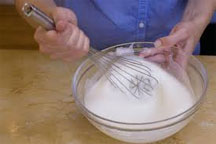 Let the whites come to room temperature before beating. Use a clean, dry, large round-bottomed glass or metal bowl, not plastic. Use a clean, dry utensil for whipping; either an electric mixer or a balloon whip works well.
Let the whites come to room temperature before beating. Use a clean, dry, large round-bottomed glass or metal bowl, not plastic. Use a clean, dry utensil for whipping; either an electric mixer or a balloon whip works well.
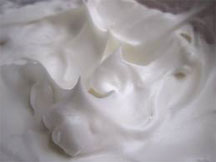 Beat the egg whites at first only until billowing. While you add the sugar, whip the whites again, this time until soft peaks form. The peaks should fall to one side when you withdraw the beater.
Beat the egg whites at first only until billowing. While you add the sugar, whip the whites again, this time until soft peaks form. The peaks should fall to one side when you withdraw the beater.
When making an Angel Food Cake from scratch, you can use granulated sugar, or even half powdered sugar and half granulated sugar. However, if you do go half and half, be sure to sift it 2 or 3 times before beating it into the egg whites. This will ensure that there are no lumps and that the sugar will blend easily with the whites. Whether granulated or powdered, add the sugar to the cake batter only a few spoonfuls at a time.
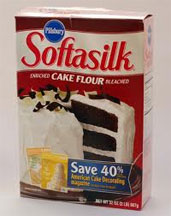 It's best to use sifted cake flour for this cake; it gives the lightest and softest texture. All-purpose flour can be used if there's no cake flour available, however. And it's important to be precise in measuring. Sift the flour before measuring it. Then add it to the whites, 1/4 at a time, by sifting it over the whites and folding it in.
It's best to use sifted cake flour for this cake; it gives the lightest and softest texture. All-purpose flour can be used if there's no cake flour available, however. And it's important to be precise in measuring. Sift the flour before measuring it. Then add it to the whites, 1/4 at a time, by sifting it over the whites and folding it in.
Fold the batter gently in a circular motion using a rubber spatula or a flat whisk and rotating the bowl as you go. Run the spatula down the side and along the bottom of the bowl, scooping the whites from the bottom to the top of the mound, incorporating the flour as you do so. Be careful not to overdo it. The flour needs to be evenly mixed with the egg whites, but over-mixing will deflate them and toughen the cake.
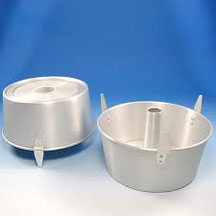 When it comes to pans, Angel Food Cake pans are traditionally tube pans. Do not grease the tube pan for a traditional Angel Food Cake. The batter must be able to cling to the sides of the pan and climb high while it bakes.
Make sure there are no large air bubbles in the batter once it has been poured into the cake pan. Smooth the top with a metal spatula, then draw the spatula through the batter in a slow circle around the center tube to release air bubbles.
When it comes to pans, Angel Food Cake pans are traditionally tube pans. Do not grease the tube pan for a traditional Angel Food Cake. The batter must be able to cling to the sides of the pan and climb high while it bakes.
Make sure there are no large air bubbles in the batter once it has been poured into the cake pan. Smooth the top with a metal spatula, then draw the spatula through the batter in a slow circle around the center tube to release air bubbles.
 To rise to their fullest, angel cakes must be baked gently in the lower part of the oven and just until lightly browned. The moment the cake emerges from the oven, it must be inverted so that it hands in the pan. If your tube pan doesn't have supports along the top rim, place the pan upside down over the neck of a bottle while the cake cools.
To rise to their fullest, angel cakes must be baked gently in the lower part of the oven and just until lightly browned. The moment the cake emerges from the oven, it must be inverted so that it hands in the pan. If your tube pan doesn't have supports along the top rim, place the pan upside down over the neck of a bottle while the cake cools.
 Run a thin spatula around the edge of the pan and center tube to loosen the cake before gently shaking it from the pan.
Run a thin spatula around the edge of the pan and center tube to loosen the cake before gently shaking it from the pan.
 Angel cakes are rarely frosted. Rather, they are served dusted with powdered sugar or topped with sliced or crushed fruit with its juice, whipped cream, or another light sauce.
Angel cakes are rarely frosted. Rather, they are served dusted with powdered sugar or topped with sliced or crushed fruit with its juice, whipped cream, or another light sauce.
To serve angel cake, cut it with a sharp serrated knife, using a light sawing motion. Or use two forks - tines facing outward - pushing them in opposite directions to break pieces of cake apart.
And finally, angel cakes freeze beautifully. Simply put it in a plastic bag. Squeeze out as much air as possible, seal, and freeze for up to 3 months.
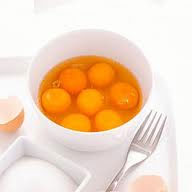 "Finally" my foot! What about all those leftover egg yolks? Yeh, this does need to be dealt with. Luckily there are a number of ways to use them.
"Finally" my foot! What about all those leftover egg yolks? Yeh, this does need to be dealt with. Luckily there are a number of ways to use them.
We can mix beaten egg yolks with milk and grated cheese for a gratin topping or as a binder for ingredients in a casserole. Or we can beat yolks with a little water for coating pounded round steak or chicken cutlets before coating them with bread crumbs. Extra egg yolks can be stirred into a frittata or used to make fresh mayonnaise. They make wonderful custard as well.
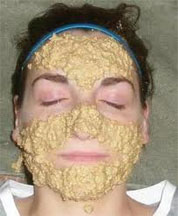 My favorite use for them, though, is in my homemade facial. I mix a couple egg yolks with oat flour, a tablespoon of honey, about 1/8 tsp cream of tartar and a few drops of lavender oil. After cleansing and exfoliating, I slather this stuff all over my face (avoiding my eyes and mouth) and neck. I lay down on my back with my head hung over the bed, close my eyes, and breathe. This once-a-month routine is really good for the skin. (I should say that this concoction is good for dry skin only.)
My favorite use for them, though, is in my homemade facial. I mix a couple egg yolks with oat flour, a tablespoon of honey, about 1/8 tsp cream of tartar and a few drops of lavender oil. After cleansing and exfoliating, I slather this stuff all over my face (avoiding my eyes and mouth) and neck. I lay down on my back with my head hung over the bed, close my eyes, and breathe. This once-a-month routine is really good for the skin. (I should say that this concoction is good for dry skin only.)
But back to the cake-making: I know all this sounds like a lot of work, but to be able to serve a dessert that's not just fat-free, but also free of preservatives, additives, artificial this and that, is worth the effort on occasion. And what a nice way to send the message to our dinner guests that they matter so much that we were willing to go to such an effort!

